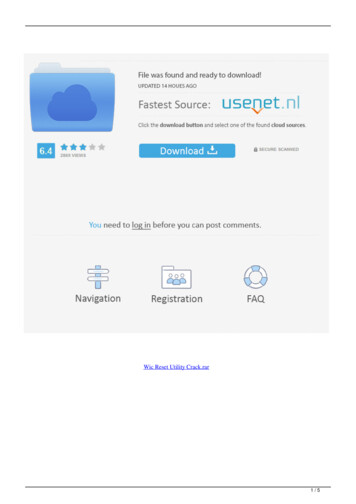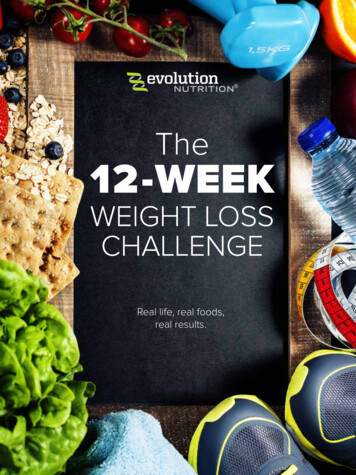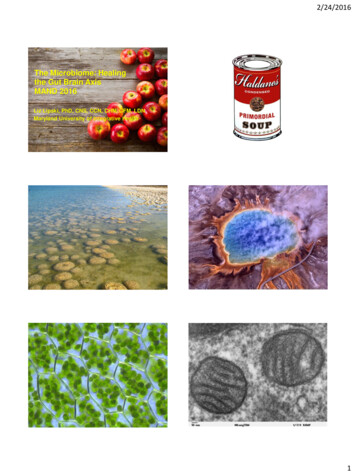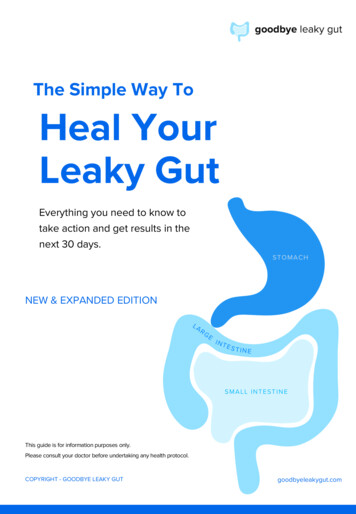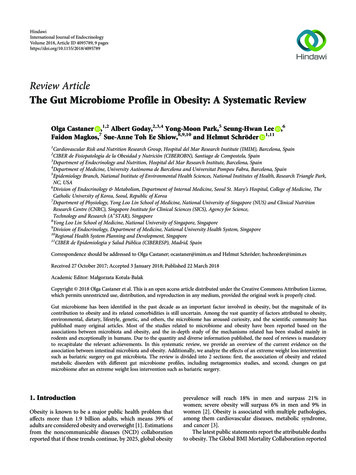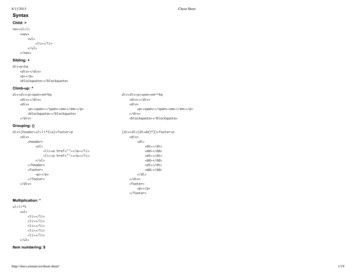
Transcription
4-WeekGut ResetAn Integrative Gastroenterologist's Guide To Gut Health & LongevityBy Dr. Marvin Singh, M.D.www.DrMarvinSingh.com
ContentsThe science of gut healthHow to heal your gutWhat to eat for better digestionA 4-week gut-healing planHow to have healthy digestion for lifeMeet Dr. Marvin Singh, M.D.35671011****The information on this e-book is not intended to take the place of medical advice from a trained medical professional who knows your detailedmedical history. Every person has unique medical issues that should be known to your medical provider. Readers are advised to consult aphysician or other qualified health professional regarding treatment of any medical conditions.***24-Week Gut Reset
The Science Of Gut HealthThere’s so much confusion over how to be well, even a sane personcould go crazy. Should we eat carbs? Is gluten still bad? Are eggs ahealth food or not? In this e-book I cut through the chaos, giving youthe real science on gut health and a simple, 4-week action plan forbetter digestion. Are you ready to heal your gut? Let’s get started.You’ve probably heard it before, but all disease really does begin in the gut. Hippocrates, wellknown as the father of modern medicine, was the first to utter those words and while he may not haverealized exactly to what extent—boy was he right! As an integrative gastroenterologist that seespatients every single day, I know better than anyone that our gut is either the thing keeping us healthyor the thing making us sick. But when we say gut health, what do we really mean? Mostly, we arereferring to the health of the gut microbiome, or the ecosystem of tens of trillions of bacteria, fungi, andviruses that live in our digestive tract.Think of your gut as a metropolis forthese little bugs, whose cells actually outnumberyour own. In fact, there is 100 times moremicrobial DNA in your gut than there is humanDNA in your whole body. Crazy, isn’t it? It’spretty clear the microbiome is a formidable force.And it doesn’t end there! The gut also containssomething called the metabolome, which isbasically all the chemicals (also known asmetabolites) that go along with the microbes. Themetabolome is what makes the wheels turn,determining whether good things or bad thingsare happening in your gut.Another important aspect of a healthy gut is the layer of cells that line the digestive tract. Thesecells are connected by structures called tight junctions, which when they are injured in some way—such as from a poor diet, stress, medications, or an imbalance in the microbiome—become morepermeable. This is bad news, allowing food particles, bacteria, and other chemicals to sneak into thebloodstream. When this happens, our immune system reacts, launching an attack against these “foreigninvaders.” This issue is also known as “leaky gut” or “increased intestinal permeability” and is a hugecontributor to poor gut health and chronic inflammation.4-Week Gut Reset3
Don’t strive for perfection:Why you want to heal your gutMy patients often ask me why it’s important toheal the gut. What I tell them is that our guthouses over 70% of our immune system and isdeeply connected to important bodily systems,even ones that seem unrelated to digestion, suchas neurotransmitter production and ourmetabolism.By creating balance in the gut microbiome andpreventing leaky gut, we can also directlyinfluence the degree of inflammation that’spresent in our body and the development (orreversal) of chronic diseases.What diseases am I talking about? Anything fromSo how do we maintain a healthy microbiome and preventincreased intestinal permeability? In the gut health world, there’s alot of focus on killing “bad” bugs and replacing them with “good”bugs, also known as probiotics. But the truth is, it actually mattersless what the individual characters in the microbiome are doing andmore how the collective system is functioning. Having a few “bad”guys in the room won’t always hurt you.A good example of this is C. diff (short for Clostridiumdifficile), one of the most famous “bad bacteria.” It’s often thoughtthat if you have C.diff, you automatically have a huge problem. Butthe truth is, I might have C. diff in my colon (and you might too!)without having any symptoms at all. That said, if the tides turn andyou have to take antibiotics or become immune suppressed, it couldallergies, Alzheimer’s dementia, anxiety andbe enough to shift the balance in the ecosystem; that C.diff could godepression to asthma, autism, autoimmuneconditions, cancer, chronic fatigue syndrome,from quietly doing nothing to producing a toxin that could make youheart disease, diabetes, Parkinson’s disease,thyroid disease, and small intestinal bacterialovergrowth—just to name a few.severely ill.When we say we want to “heal the gut,” we don’t mean adigestive tract with heaps of great bacteria and zero bad ones. Wesimply want to establish a system that’s tilted towards doing good.In other words: strive for health—not perfection.4-Week Gut Reset4
How To Heal Your GutNow that we know what a healthy gut looks and feels like, and why it’s so important to keep our guts healthyfor life, how do we go about it? In this plan we’ll be taking a holistic approach, which means avoiding toxins,exercising, sleeping well, reducing stress, and enjoying social connections as well as focusing on nutrition. It mightseem strange that these things would be part of a gut health plan, but there’s solid science telling us that all thesefactors impact the gut microbiome as much as our diet. If you are under too much stress, the gut microbiome can gohaywire just as if you were eating fast food every other day. Yes, really.So what does this mean for you for the next 4weeks? It means you’re going to revamp your wholelifestyle—not just the way you eat—to heal your gut.The good news is that a little goes a long way. Whenyou start making healthy lifestyle choices, yourmicrobiome responds positively almost immediately.As a result, the metabolome is modulated and youstart filling your body with beneficial antioxidantsand chemicals. At the same time, your immunesystem becomes stronger and you’re able to modifygene expression in a positive way. When things gowell, the whole system prospers. In fact, one studyshowed that among those who practice four or morehealthy lifestyle behaviors, there is a 66% lower allcause mortality compared to those with unhealthylifestyle behaviors. Just think about that for a second:If you practice healthy habits, you have asubstantially reduced risk of dying from any cause.You might be thinking: This is all well and good Dr. Singh—but what will I be eating for the next fourweeks? I get it. We know that diet is the key to health, especially when it comes to our digestion. So what diet isbest for gut health? There’s a great deal of data on this topic and it can feel like a windstorm of opinions andconflicting information. For example, we know that the Mediterranean diet helps decrease E.coli (one of those“bad bacteria”) in the gut and helps increase numbers of helpful bacteria. That said, there are also studiesshowing that a vegan diet, carnivorous diet, paleo diet, SCD diet, GAPS diet, and many more are also good foryou. The truth is that there is no best diet for gut health, especially when we’re thinking long-term. This is why Ialways recommend working with a nutrition-savvy healthcare provider to nail down the best diet for you basedon your unique needs (more on that on page 10). That said, there are some key nutrition principles—and toolslike the keto diet and intermittent fasting—that we can all take advantage of to get our gut health back on track.On the next page, I’ll give you an exact list of foods to eat and foods to avoid during the 4 week plan.54-Week Gut Reset5
What To Eat For Better DigestionYou’re almost ready to get started! Here’s a list of what to eat and what toavoid while on the 4-Week Gut Reset plan. The basic principle here is toavoid inflammatory, microbiome-disrupting foods. Want a pro tip? Getfamiliar with these foods and stock up on them before Day 1. You’ll likelybe fatigued during the first week and probably won’t feeling likeshopping.6What to eat:What to avoid:Stick to fresh, low-carb foods including lowglycemic vegetables and fruits, healthy fats, andclean meats. Go organic and non-GMO as muchas possible.Stay away from processed and refinedfoods, starchy foods, carbs, grains, sugars(of all kinds), and inflammatory fats. Wild caught Alaskan Salmon Sardines Shrimp Grass fed, organic beef Organic chicken Organic turkey Avocado Free range, organic eggs Nuts (macadamia and walnuts are my favorite) Arugula Spinach Broccoli Cauliflower Zucchini Brussel sprouts Cabbage Celery Kale Blackberries Raspberries Blueberries Extra virgin olive oil and olives Grass fed butter or ghee (in moderation) Sparkling mineral water Unsweetened herbal teas Bone broth Grass fed, organic hard cheese 4-Week Gut Reset ChickpeasLentilsSweet potatoesBananasPineapplesOrangesGrapesMangoesDried fruitsHoneyAgave nectarCane sugarArtificial sweetenersHigh fructose corn syrup (I recommendcutting this one out for good)Sodas (diet or regular)Fruit juicesBeer/wine/cocktailsHot dogs and baconProcessed lunch meatFast food of any kindVegetable oilsCandyBread/wheatMuffins, cakes, pastasPeasCornWhite rice6
WEEK 1Despite what you may have seen advertised, there’s no quick fix to healyour gut. But you can make a lot of progress in just one month! Byfollowing this 4-week program, you can get back on the path of healthand wellness. This week is all about setting a heathy foundation anddoing a hard reset on the gut microbiome.1. Start your journal: Imagine yourself four weeks from now, on the last day of the 4-week plan.Write down how it feels and how you see yourself getting there. What motivates you? What is your“why” and what do you want to accomplish? Make this the first entry in the journal that you willkeep throughout your journey.2. Clean out your pantry: You’ve already stocked up on fresh foods, but it’s also a good idea to getthe “avoid” foods out of sight. Rid your pantry of anything with added sugar and say goodbye toprocessed and/or packaged foods. Only keep healthy pantry foods like nuts and spices.3. Consider going keto: If you don’t have any contraindications, consider making the ketogenic dietpart of your plan. This is a low-carb, moderate-protein, high-fat diet. if you’re not able to do theketogenic diet because of a health issue or other factor, don't fret. You can still reset and reboot!You may need to adjust your macros by eating less fat and more healthy carbs. You can also be alittle stricter on when it comes to fasting (which you’ll start in Week 2).4. Get plenty of sleep: Make sure you are getting enough sleep and rest. You’ll likely feel fatiguedthis week and if you are sleep deprived, your body will be screaming for carbs!5. Stay hydrated: Make sure you stay hydrated and drink more water than you would normally. Youcan also add some salt and electrolytes for an added mineral boost.6. Supplement with magnesium: Consider taking a magnesium supplement for this first week; thismay also help keep regular because people can sometimes get constipated when changing theireating habits. I recommend about 200 mg of magnesium citrate each day.7. Eat your veggies: Everyone should strive to eat plenty of leafy greens and vegetables while on aketogenic diet. They are low-carb and chock full of important nutrients.The Ketogenic Diet As A Wellness ToolFrom afar, the ketogenic diet can seem extreme or unattainable (I mean, is a life without carbs really a lifeat all?). I’m a realist, which means I recognize the benefits of the keto diet and also recognize that mostpeople cannot maintain such a restrictive diet for long. That’s why on this plan we’re using the keto diet asa short-term therapeutic tool, instead of a long-term lifestyle plan. This allows you to take advantage of thebenefits of ketosis before adopting a more flexible way of eating once the 4 weeks are over.Speaking of the benefits of ketosis we now have evidence that the ketogenic diet can increase themicrobial diversity in the gut, reduce blood sugar levels, and lower weight by increasing helpful bacteria likeAkkermansia muciniphila and Lactobacillus. At the same time, it reduces pro-inflammatory microbes likeDesulfovibrio and Turicibacter. After 6 months on a ketogenic diet, one study showed that the bacterialrichness rebounded in those with multiple sclerosis.It’s a common misconception that you have to be a meat eater to do the ketogenic diet. In fact, you caneven be a vegan and take advantage of the health benefits of this diet! You are not eating higher thannormal amounts of animal protein. In fact, you want to eat a standard amount of protein, around 20% ofyour daily calorie intake. Your carbohydrate intake should be around 5% and the rest is healthy fats likesalmon, avocado, and olive oil.4-Week Gut Reset7
WEEK 2You made it through the first week, which is definitely the hardest of thefour. Week two is all about upping the ante by adding supplements,experimenting with intermittent fasting, and getting back to yourexercise routine.1. Check on your progress: By now, you should be in full swing with the ketogenic diet and you arelikely wondering how close to nutritional ketosis you are. You will want to monitor your progresswith a ketone meter (preferably using a blood spot result).2. Introduce fasting: Similar to the ketogenic diet, we’ll be using fasting as a therapeutic tool duringthis 4-week plan. It can feel intimidating from afar, but fasting doesn’t have to be extreme. Startsimple by leaving a 12-hour window of time between dinner and breakfast the next morning.Ideally, by the end of the 4 weeks you will have increased this to a 16-hour window (but go at yourown pace).3. Make time: Look at your schedule and block off 30 minutes for at least three days during the weekwhen you can exercise and get that heart pumping. Bonus points if you do something outdoors!4. Add supplements: Go for a nice multi-vitamin with plenty of B vitamins. Milk thistle and NAC aregreat options to support the detoxification process. Vitamin D, omega-3s (especially if you’re noteating fish regularly) and turmeric are also helpful to add to your routine.5. Be kind to yourself: If you get derailed and fall off the wagon, it's no big deal. Just start over withthe 4 week plan and go from there.The Science of FastingYou’ve probably heard chatter about intermittentfasting. It’s a key concept in health, wellness, andlongevity—and we’re using it as a tool to restorehealthy digestion in this plan. But what does thescience say about fasting and the microbiome?A recent study showed that every-other-day fastingcan selectively activate beige fat, which is key toweight loss, by shaping the gut microbiome andshifting its metabolomics.Another study demonstrated how fastingmimicking diet cycles were able to reduceintestinal inflammation, increase stem cell number,stimulate protective gut microbes, and reverseintestinal pathology caused by a chemicallyinduced colitis. Isn’t that fascinating?Fasting isn’t just about restricting caloric intake orlosing water weight. It’s about renewing andresetting your metabolism, and using your gutmicrobiome to make it happen.4-Week Gut Reset8
WEEK 3Congrats! You’re halfway there. This week, it’s time to focus on diversity inthe foods you’re eating. It’s also time to get out there and be social ifyou’ve been isolating yourself. No more putting your life on hold!1. Go for diversity: Make sure you’re not eating the same thing over and over again. It’s easy to finda few good recipes and get stuck on them for weeks on end. If you do this, you’ll inevitably getbored and slip up. Eat a wide variety of colorful vegetables and low-glycemic fruits, like berries.2. Take a mindful moment: This is a good time to start practicing some mindfulness if you don’talready have a go-to practice. I love doing breathwork. The 4-7-8 breath is a great, relaxingpractice to help you feel grounded, present, and in the moment. (Here’s a video that shows exactlyhow it’s done.)3. Get social: Make sure you take some time to hang out with friends. You are at the midway pointand you should remind yourself that this isn’t a punishment. Invite your friends to get an herbal teaor go for a walk and celebrate the fact that you are in the driver’s seat and on the path to wellness.4. Incorporate tea into your routine: Speaking of tea, make sure you’re drinking anti-inflammatoryteas like green tea and oolong tea. My personal favorite is jasmine green tea.5. Bonus: If it's in your budget, book an infrared sauna session this week. This is a great way to winddown and sweat it out, and they’re thought to support the detoxification process, weight loss, ahealthy metabolism, and more.4-Week Gut Reset9
WEEK 4You’re almost there! By now you should be starting to feel some of theclouds lifting off your head and you may feel stronger, happier, andmore energetic. Keep it up—you’re doing great!1. Plan ahead: This is a great time to think about what you’re going to do at the end of week four.You can continue with the current plan for a longer period of time or adopt something that is moreflexible and designed for you as an individual based on your gut microbiome, genetics,sensitivities, environment, and lifestyle.2. Experiment with herbs: If you’re in need of some help with stress reduction, look at the categoryof herbs called adaptogens. My personal favorite is ashwagandha and you can add it right to yourmorning smoothie or take it in a supplement capsule.3. Purge your home of toxins: This is a good time to learn more about the beauty products,cosmetics, soaps, and lotions you use. Go to https://www.ewg.org to learn about what changesyou could make to your routine. While toxins are on the brain, look at the water supply in yourhouse and think about drinking filtered water, instead of tap.4. Take your fasting to a new level: Consider tightening up your fasting window and eating in anarrower period of time.Work With An ExpertOn this plan we’re working to reset ourgut microbiome using fasting and the ketodiet—and by avoiding common problemfoods. During this journey, it’s alsohelpful to gain a better understanding ofthe exact composition of your gutmicrobiome, the specific conditions youmay have, and address any longstandingimmune or inflammatory issues that needto be addressed in order for you to achieveoptimal gut health.This requires a professional, which is whyI recommend working with a healthcareprovider that can sort through your healthhistory, create a personalized treatmentplan, and help you establish a plan forhow you’ll be eating in the long-term afterthis plan is over.Look for a physician who has had formaltraining in integrative or functionalmedicine. They will be able to order labtesting, write prescriptions (if needed),and make personalized lifestyle andsupplement recommendations.4-Week Gut Reset10
Healthy Digestion for LifeYou made it! Rest assured that your gut is in a much better place todaythan it was 4 weeks ago, before you turned your lifestyle on its head. Nowit's time to transition to a more sustainable way of eating and living, whilecontinuing to show your gut plenty of love.Remember, the diet you’ve been following overthe past 4-weeks has been a therapeutic diet. So while itserved the purpose of resetting your gut, it’s restrictive andnot something I’d expect you to maintain long-term. (Plus,there’s actually not much evidence on whether maintaininga strictly low-carb diet for long periods of time will reallybenefit your health.)So how do you establish a way of eating that youcan maintain for the rest of your life, while still upholdingyour newfound gut health? Nailing down a lifestyle planthat works for you in the long-term is all aboutsustainability. You’re human and want enjoy life. Youwant to have cake on your birthday! You want to be able toenjoy a late-night snack every now and again. I’m here totell you that it’s okay to let your guard down once in awhile, as long as you maintain a healthy foundationoverall. A the end of the day, you’re the one who has tocook and eat the food—so it’s important to pick a nutritionplan that works for your health, lifestyle, schedule, andtaste buds.The good news is that you can take the keyprinciples of keto and fasting that you’ve been using overthe last month and adapt them to your lifestyle. What doesthis look like? You might continue with your 16-hourfasting window at least a few days a week and try afasting-mimicking diet once or twice a year. Or, if you’vebeen indulging in carbs while on vacation, you might try cycling back on the low-carb keto diet for a fewweeks. The keto diet and fasting don’t have to be done 24:7 to work; in fact, they are great tools to use inthe shorter term when you want to get back on track. Despite what many people will tell you, it doesn’thave to be all or nothing.Moving forward, the more individualized your nutrition plan, the better. There is no universal dietthat I’d recommend every single person should follow long-term, which is why establishing a personalizedprotocol based on your gut microbiome, nutritional genetics, epigenetics, sensitivities, exposures, and othermedical conditions is so important. This type of plan is sustainable because it’s specific and tailored to yourunique needs. You’re only eliminating or limiting foods that are a problem for YOU, not ones we suspectmight be a problem from a population standpoint. When it comes to nutrition, the more personalized thebetter. I recommend working with an integrative gastroenterologist who is able to create a highlyindividualized plan and guide you through it every step of the way. As a physician, this is what I love doingthe most! As a general rule, continue pairing healthy fats with plenty of colorful vegetables and fruits, eat amoderate amount of protein, and keep your diet clean, organic, and whole-foods based. Eat what makes youfeel good, and don't get lost in what's trendy or new if it's not working for you.4-Week Gut Reset11
Meet Dr. Marvin Singh, M.D.Dr. Marvin Singh is America's premier wellness concierge. Hepractices as an integrative gastroenterologist in San Diego,California, is a diplomate of the American Board of IntegrativeMedicine, board certified internist and gastroenterologist. Dr.Singh was trained by Dr. Andrew Weil, a pioneer in the field ofintegrative medicine, at the University of Arizona Center forIntegrative Medicine. Dr. Singh is currently a voluntaryassistant clinical professor at UCSD in the Department ofFamily Medicine and Public Health; prior to this, he has been aclinical assistant professor at UCLA and an assistant professorof medicine at Johns Hopkins University.Dr. Singh is a member of the American Academy of AntiAging Medicine, American College of Lifestyle Medicine, andthe True Health Initiative, among many other societies. He isactively involved in the American GastroenterologicalAssociation and American Medical Association. He is coediting the textbook of Integrative Gastroenterology 2nd editionand has already written several book chapters and articles.He is dedicated to guiding his patients toward optimal wellnessevery step of the way, in whatever manner they need. He usescutting-edge tests and personally designed protocols to developtruly individualized plans based on genetics, microbiome,metabolism, and lifestyle. A graduate of VirginiaCommonwealth University School of Medicine, Dr. Singhcompleted his residency training in internal medicine at theUniversity of Michigan Health System followed by fellowshiptraining in Gastroenterology at Scripps Clinic/Green Hospital.Connect with @DrMarvinSingh on Facebook, Twitter, Instagramor visithttp://www.DrMarvinSingh.com/4-Week Gut Reset12
Copyright Dr. Marvin Singh, 2019All rights reserved. No part of this publication may be reproduced, distributed, or transmittedin any form or by any means, including photocopying, recording, or other electronic ormechanical methods, without the prior written permission of the publisher, except in the caseof brief quotations embodied in critical reviews and certain other noncommercial usespermitted by copyright law.4-Week Gut Reset13
May 04, 2019 · 3. Consider going keto: If you don’t have any contraindications, consider making the ketogenic diet part of your plan. This is a low-carb, moderate-protein, high-fat diet. if you’re not able to do the ketogenic diet because of a health issue or
